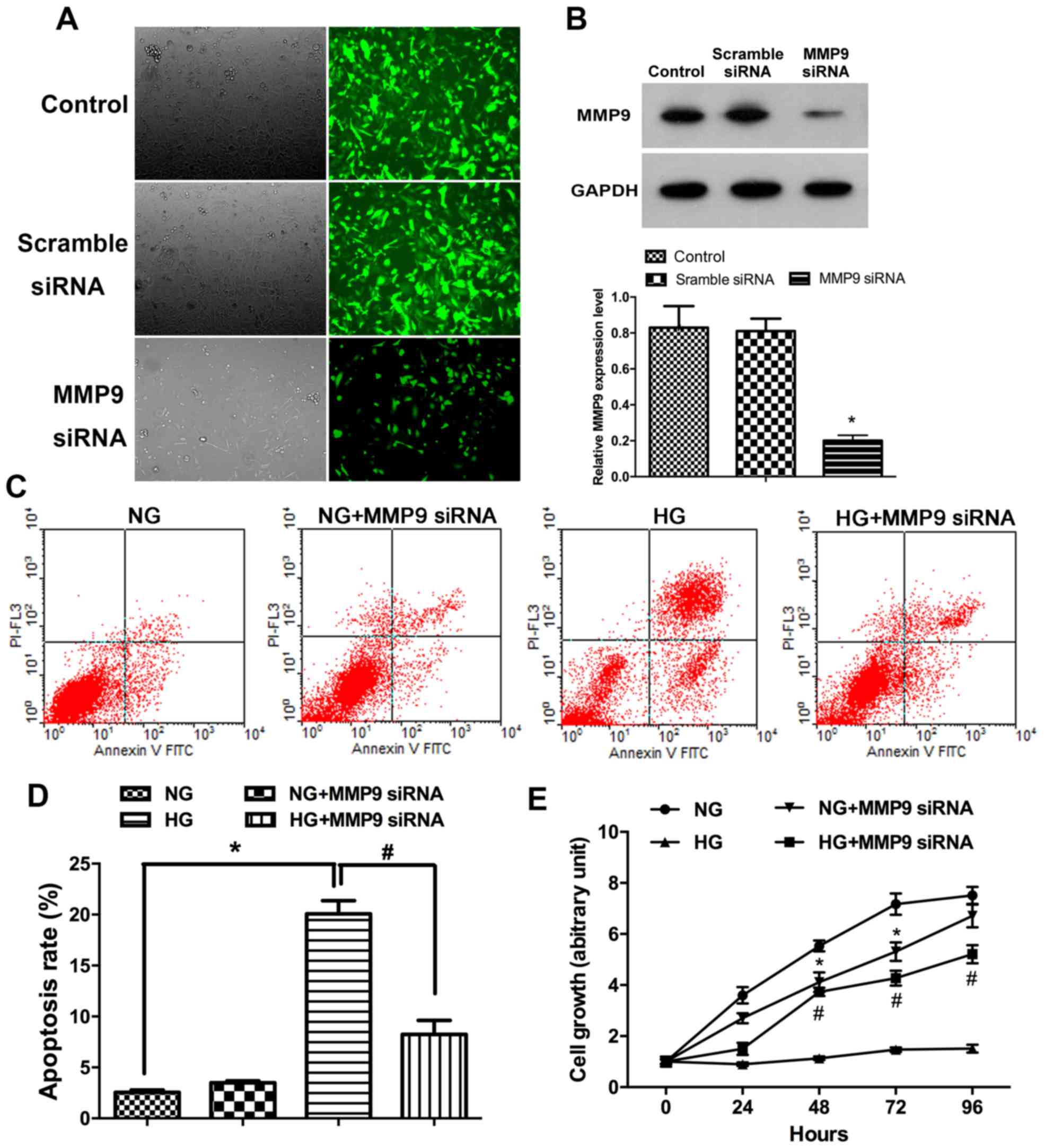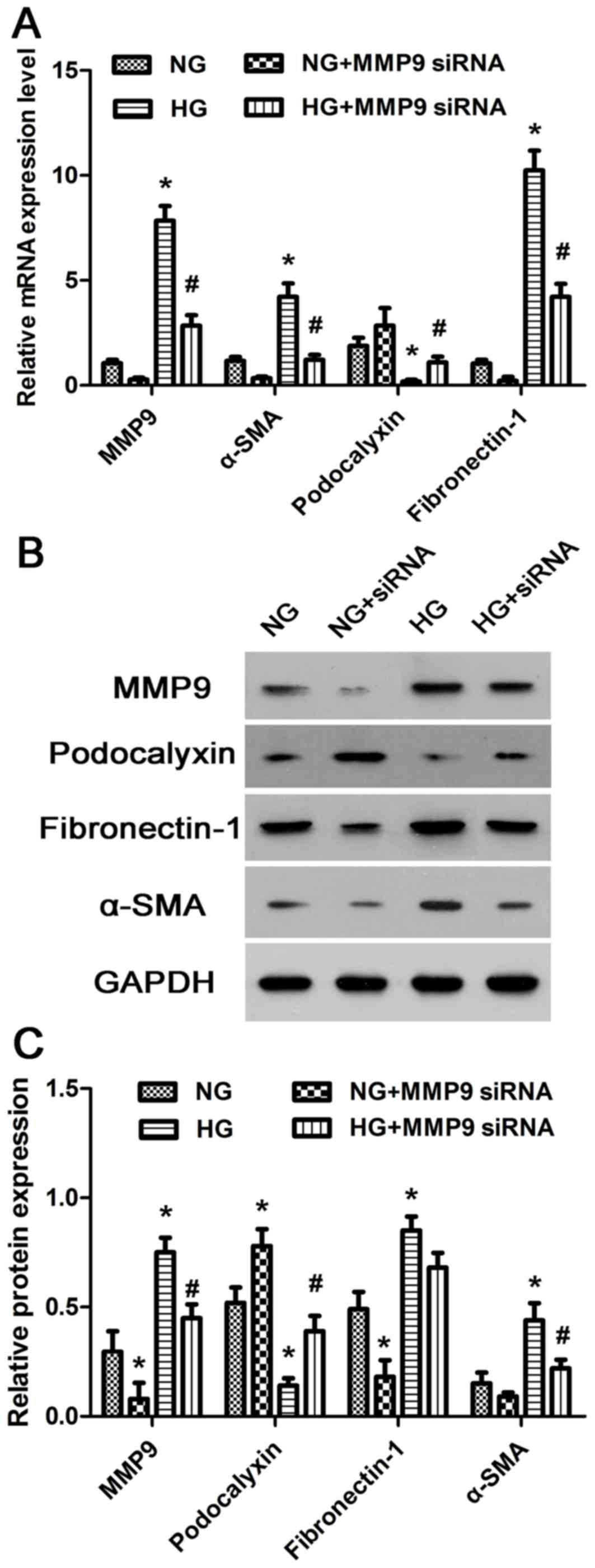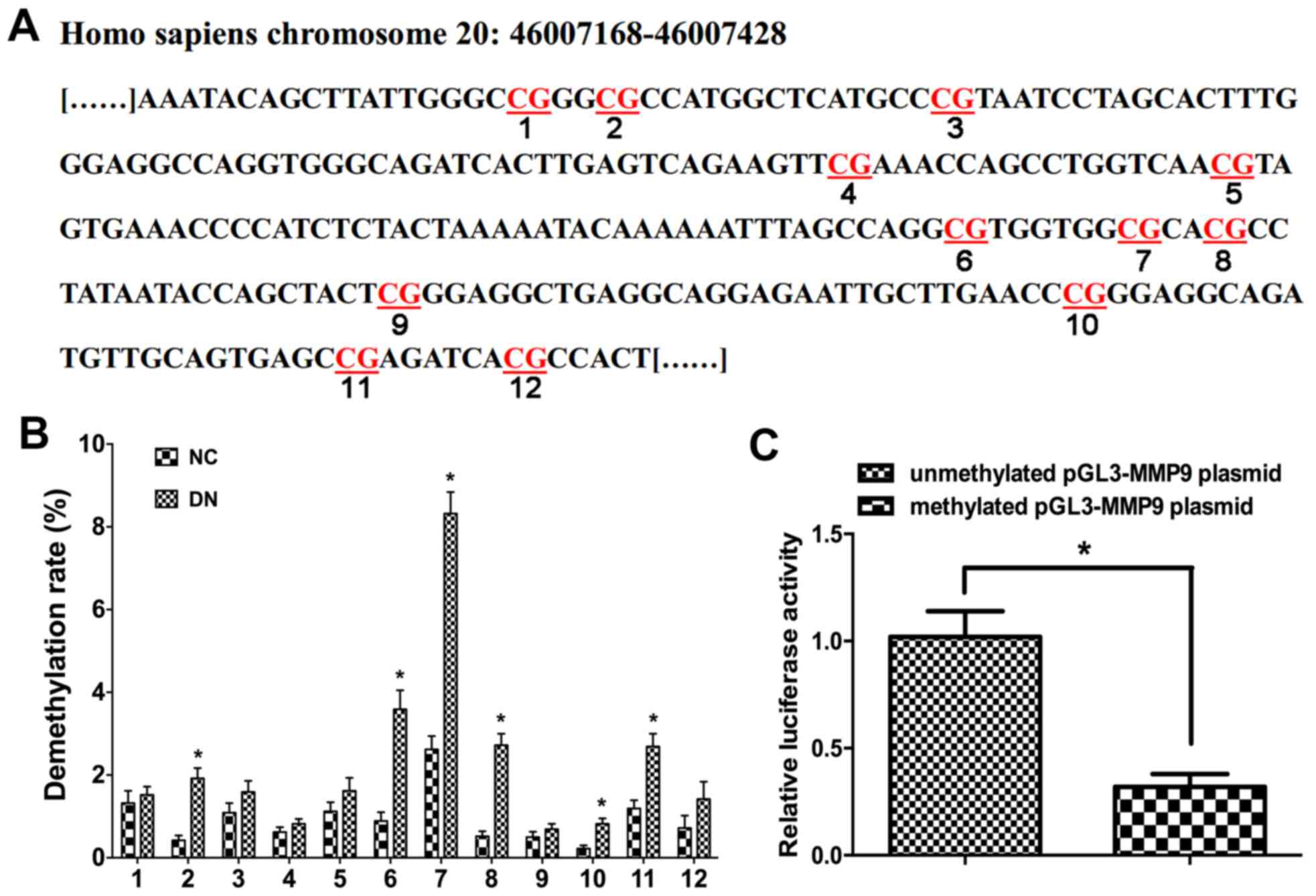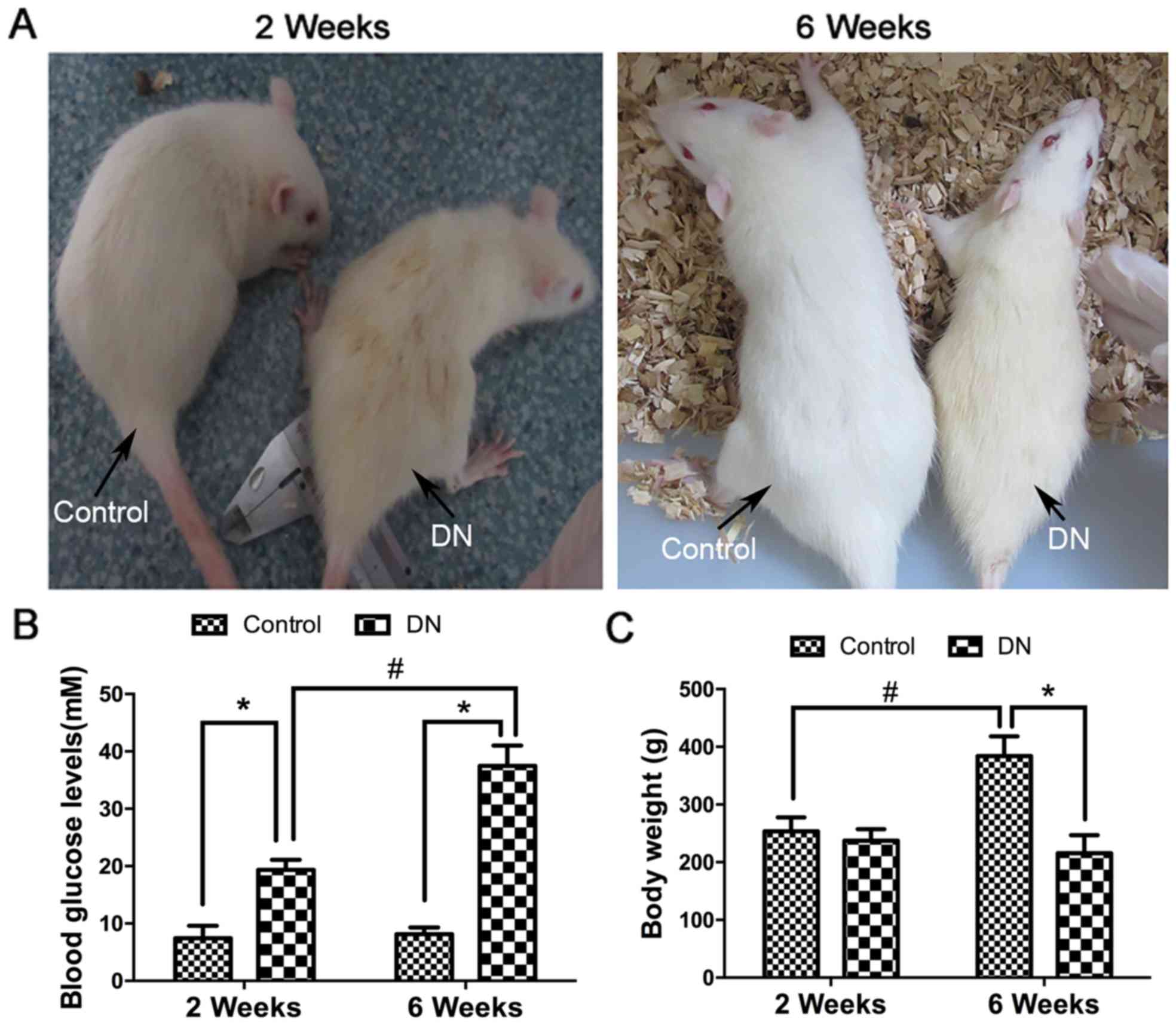|
1
|
Gamella-Pozuelo L, Fuentes-Calvo I,
Gomez-Marcos MA, Recio-Rodriguez JI, Agudo-Conde C,
Fernandez-Martin JL, Cannata-Andia JB, Lopez-Novoa JM, Garcia-Ortiz
L and Martinez-Salgado C: Plasma cardiotrophin-1 as a marker of
hypertension and diabetes-induced target organ damage and
cardiovascular risk. Medicine (Baltimore). 94:e12182015. View Article : Google Scholar : PubMed/NCBI
|
|
2
|
Menini S, Iacobini C, Ricci C, Blasetti
Fantauzzi C and Pugliese G: Protection from diabetes-induced
atherosclerosis and renal disease by D-carnosine-octylester:
Effects of early vs late inhibition of advanced glycation
end-products in Apoe-null mice. Diabetologia. 58:845–853. 2015.
View Article : Google Scholar : PubMed/NCBI
|
|
3
|
Khan S, Jena G and Tikoo K: Sodium
valproate ameliorates diabetes-induced fibrosis and renal damage by
the inhibition of histone deacetylases in diabetic rat. Exp Mol
Pathol. 98:230–239. 2015. View Article : Google Scholar : PubMed/NCBI
|
|
4
|
Leehey DJ, Zhang JH, Emanuele NV,
Whaley-Connell A, Palevsky PM, Reilly RF, Guarino P and Fried LF;
VA NEPHRON-D Study Group, : BP and renal outcomes in diabetic
kidney disease: The veterans affairs nephropathy in diabetes trial.
Clin J Am Soc Nephrol. 10:2159–2169. 2015. View Article : Google Scholar : PubMed/NCBI
|
|
5
|
Zhao L, Wang X, Sun L, Nie H, Liu X, Chen
Z and Guan G: Critical role of serum response factor in podocyte
epithelial-mesenchymal transition of diabetic nephropathy. Diab
Vasc Dis Res. 13:81–92. 2016. View Article : Google Scholar : PubMed/NCBI
|
|
6
|
Chen XW, Du XY, Wang YX, Wang JC, Liu WT,
Chen WJ, Li HY, Peng FF, Xu ZZ, Niu HX and Long HB: Irbesartan
ameliorates diabetic nephropathy by suppressing the
RANKL-RANK-NF-κB pathway in type 2 diabetic db/db mice. Mediators
Inflamm. 2016:14059242016. View Article : Google Scholar : PubMed/NCBI
|
|
7
|
Zhang Y, Ma KL, Liu J, Wu Y, Hu ZB, Liu L,
Lu J, Zhang XL and Liu BC: Inflammatory stress exacerbates lipid
accumulation and podocyte injuries in diabetic nephropathy. Acta
Diabetol. 52:1045–1056. 2015. View Article : Google Scholar : PubMed/NCBI
|
|
8
|
Sweetwyne MT, Gruenwald A, Niranjan T,
Nishinakamura R, Strobl LJ and Susztak K: Notch1 and Notch2 in
Podocytes Play Differential Roles During Diabetic Nephropathy
Development. Diabetes. 64:4099–4111. 2015. View Article : Google Scholar : PubMed/NCBI
|
|
9
|
Yasuda-Yamahara M, Kume S, Tagawa A,
Maegawa H and Uzu T: Emerging role of podocyte autophagy in the
progression of diabetic nephropathy. Autophagy. 11:2385–2386. 2015.
View Article : Google Scholar : PubMed/NCBI
|
|
10
|
Andeen NK, Nguyen TQ, Steegh F, Hudkins
KL, Najafian B and Alpers CE: The phenotypes of podocytes and
parietal epithelial cells may overlap in diabetic nephropathy.
Kidney Int. 88:1099–1107. 2015. View Article : Google Scholar : PubMed/NCBI
|
|
11
|
Zhou HL, Wang YT, Gao T, Wang WG and Wang
YS: Distribution and expression of fibroblast-specific protein
chemokine CCL21 and chemokine receptor CCR7 in renal allografts.
Transplant Proc. 45:pp. 538–545. 2013; View Article : Google Scholar : PubMed/NCBI
|
|
12
|
Omori K, Hattori N, Senoo T, Takayama Y,
Masuda T, Nakashima T, Iwamoto H, Fujitaka K, Hamada H and Kohno N:
Inhibition of plasminogen activator inhibitor-1 attenuates
transforming growth factor-β-dependent epithelial mesenchymal
transition and differentiation of fibroblasts to myofibroblasts.
PLoS One. 11:e01489692016. View Article : Google Scholar : PubMed/NCBI
|
|
13
|
Brandner JM, Zacheja S, Houdek P, Moll I
and Lobmann R: Expression of matrix metalloproteinases, cytokines,
and connexins in diabetic and nondiabetic human keratinocytes
before and after transplantation into an ex vivo wound-healing
model. Diabetes Care. 31:114–120. 2008. View Article : Google Scholar : PubMed/NCBI
|
|
14
|
Guo J, Xu Y, Ji W, Song L, Dai C and Zhan
L: Effects of exposure to benzo[a]pyrene on metastasis of breast
cancer are mediated through ROS-ERK-MMP9 axis signaling. Toxicol
Lett. 234:201–210. 2015. View Article : Google Scholar : PubMed/NCBI
|
|
15
|
Zhong Y, Zhang X, Cai X, Wang K, Chen Y
and Deng Y: Puerarin attenuated early diabetic kidney injury
through down-regulation of matrix metalloproteinase 9 in
streptozotocin-induced diabetic rats. PLoS One. 9:e856902014.
View Article : Google Scholar : PubMed/NCBI
|
|
16
|
Wang XM, Shi K, Li JJ, Chen TT, Guo YH,
Liu YL, Yang YF and Yang S: Effects of angiotensin II intervention
on MMP-2, MMP-9, TIMP-1, and collagen expression in rats with
pulmonary hypertension. Genet Mol Res. 14:1707–1717. 2015.
View Article : Google Scholar : PubMed/NCBI
|
|
17
|
Lelongt B, Bengatta S, Delauche M, Lund
LR, Werb Z and Ronco PM: Matrix metalloproteinase 9 protects mice
from anti-glomerular basement membrane nephritis through its
fibrinolytic activity. J Exp Med. 193:793–802. 2001. View Article : Google Scholar : PubMed/NCBI
|
|
18
|
Luo W, Hu L, Li W, Xu G, Xu L, Zhang C and
Wang F: Epo inhibits the fibrosis and migration of Müller glial
cells induced by TGF-β and high glucose. Graefes Arch Clin Exp
Ophthalmol. 254:881–890. 2016. View Article : Google Scholar : PubMed/NCBI
|
|
19
|
Kang YS, Li Y, Dai C, Kiss LP, Wu C and
Liu Y: Inhibition of integrin-linked kinase blocks podocyte
epithelial-mesenchymal transition and ameliorates proteinuria.
Kidney Int. 78:363–373. 2010. View Article : Google Scholar : PubMed/NCBI
|
|
20
|
Nakamura T, Ushiyama C, Suzuki S, Hara M,
Shimada N, Ebihara I and Koide H: Urinary excretion of podocytes in
patients with diabetic nephropathy. Nephrol Dial Transplant.
15:1379–1383. 2000. View Article : Google Scholar : PubMed/NCBI
|
|
21
|
Thomas MC: Epigenetic mechanisms in
diabetic kidney disease. Curr Diab Rep. 16:312016. View Article : Google Scholar : PubMed/NCBI
|
|
22
|
Ling L, Ren M, Yang C, Lao G, Chen L, Luo
H, Feng Z and Yan L: Role of site-specific DNA demethylation in
TNFα-induced MMP9 expression in keratinocytes. J Mol Endocrinol.
50:279–90. 2013. View Article : Google Scholar : PubMed/NCBI
|
|
23
|
Chaturvedi P, Kalani A, Givvimani S, Kamat
PK, Familtseva A and Tyagi SC: Differential regulation of DNA
methylation versus histone acetylation in cardiomyocytes during
HHcy in vitro and in vivo: An epigenetic mechanism. Physiol
Genomics. 46:245–255. 2014. View Article : Google Scholar : PubMed/NCBI
|
|
24
|
Delgado-Olguin P, Dang LT, He D, Thomas S,
Chi L, Sukonnik T, Khyzha N, Dobenecker MW, Fish JE and Bruneau BG:
Ezh2-mediated repression of a transcriptional pathway upstream of
Mmp9 maintains integrity of the developing vasculature.
Development. 141:4610–4617. 2014. View Article : Google Scholar : PubMed/NCBI
|
|
25
|
Jackson MT, Moradi B, Smith MM, Jackson CJ
and Little CB: Activation of matrix metalloproteinases 2, 9, and 13
by activated protein C in human osteoarthritic cartilage
chondrocytes. Arthritis Rheumatol. 66:1525–1536. 2014. View Article : Google Scholar : PubMed/NCBI
|
|
26
|
Saleem MA, O'Hare MJ, Reiser J, Coward RJ,
Inward CD, Farren T, Xing CY, Ni L, Mathieson PW and Mundel P: A
conditionally immortalized human podocyte cell line demonstrating
nephrin and podocin expression. J Am Soc Nephrol. 13:630–638.
2002.PubMed/NCBI
|
|
27
|
Livak KJ and Schmittgen TD: Analysis of
relative gene expression data using real-time quantitative PCR and
the 2(-Delta Delta C(T) method. Methods. 25:402–408. 2001.
View Article : Google Scholar : PubMed/NCBI
|
|
28
|
Baydas G, Nedzvetskii VS, Nerush PA,
Kirichenko SV and Yoldas T: Altered expression of NCAM in
hippocampus and cortex may underlie memory and learning deficits in
rats with streptozotocin-induced diabetes mellitus. Life Sci.
73:1907–1916. 2003. View Article : Google Scholar : PubMed/NCBI
|
|
29
|
Heiland DH, Ferrarese R, Claus R, Dai F,
Masilamani AP, Kling E, Weyerbrock A, Kling T, Nelander S and Carro
MS: c-Jun-N-terminal phosphorylation regulates DNMT1 expression and
genome wide methylation in gliomas. Oncotarget. 8:6940–6954. 2017.
View Article : Google Scholar : PubMed/NCBI
|
|
30
|
Lewko B, Golos M, Latawiec E, Angielski S
and Stepinski J: Regulation of cGMP synthesis in cultured podocytes
by vasoactive hormones. J Physiol Pharmacol. 57:599–610.
2006.PubMed/NCBI
|
|
31
|
Pfeifer GP: Mutagenesis at methylated CpG
sequences. Curr Top Microbiol Immunol. 301:259–281. 2006.PubMed/NCBI
|
|
32
|
Carr SM, Poppy Roworth A, Chan C and La
Thangue NB: Post-translational control of transcription factors:
Methylation ranks highly. FEBS J. 282:4450–4465. 2015. View Article : Google Scholar : PubMed/NCBI
|
|
33
|
Zhang Z, Zhu LL, Jiang HS, Chen H, Chen Y
and Dai YT: Demethylation treatment restores erectile function in a
rat model of hyperhomocysteinemia. Asian J Androl. 18:763–768.
2016. View Article : Google Scholar : PubMed/NCBI
|
|
34
|
Lu W, Li J, Ren M, Zeng Y, Zhu P, Lin L,
Lin D, Hao S, Gao Q, Liang J, et al: Role of the mevalonate pathway
in specific CpG site demethylation on AGEs-induced MMP9 expression
and activation in keratinocytes. Mol Cell Endocrinol. 411:121–129.
2015. View Article : Google Scholar : PubMed/NCBI
|
|
35
|
Zaina S, Goncalves I, Carmona FJ, Gomez A,
Heyn H, Mollet IG, Moran S, Varol N and Esteller M: DNA methylation
dynamics in human carotid plaques after cerebrovascular events.
Arterioscler Thromb Vasc Biol. 35:1835–1842. 2015. View Article : Google Scholar : PubMed/NCBI
|
|
36
|
Ling L, Ren M, Yang C, Lao G, Chen L, Luo
H, Feng Z and Yan L: Role of site-specific DNA demethylation in
TNFα-induced MMP9 expression in keratinocytes. J Mol Endocrinol.
50:279–290. 2013. View Article : Google Scholar : PubMed/NCBI
|
|
37
|
López-Novoa JM and Nieto MA: Inflammation
and EMT: An alliance towards organ fibrosis and cancer progression.
EMBO Mol Med. 1:303–314. 2009. View Article : Google Scholar : PubMed/NCBI
|
|
38
|
Cufí S, Vazquez-Martin A,
Oliveras-Ferraros C, Martin-Castillo B, Joven J and Menendez JA:
Metformin against TGFβ-induced epithelial-to-mesenchymal transition
(EMT): from cancer stem cells to aging-associated fibrosis. Cell
Cycle. 9:4461–4468. 2010. View Article : Google Scholar : PubMed/NCBI
|
|
39
|
Zhang W, Miao J, Ma C, Han D and Zhang Y:
β-Casomorphin-7 attenuates the development of nephropathy in type I
diabetes via inhibition of epithelial-mesenchymal transition of
renal tubular epithelial cells. Peptides. 36:186–191. 2012.
View Article : Google Scholar : PubMed/NCBI
|
|
40
|
Song Y, Gong K, Yan H, Hong W, Wang L, Wu
Y, Li W, Li W and Cao Z: Sj7170, a unique dual-function peptide
with a specific α-chymotrypsin inhibitory activity and a potent
tumor-activating effect from scorpion venom. J Biol Chem.
289:11667–11680. 2014. View Article : Google Scholar : PubMed/NCBI
|
|
41
|
Lee WT, Lee TH, Cheng CH, Chen KC, Chen YC
and Lin CW: Antroquinonol from Antrodia Camphorata suppresses
breast tumor migration/invasion through inhibiting ERK-AP-1- and
AKT-NF-κB-dependent MMP-9 and epithelial-mesenchymal transition
expressions. Food Chem Toxicol. 78:33–41. 2015. View Article : Google Scholar : PubMed/NCBI
|
|
42
|
Lee DG, Lee SH, Kim JS, Park J, Cho YL,
Kim KS, Jo DY, Song IC, Kim N, Yun HJ, et al: Loss of NDRG2
promotes epithelial-mesenchymal transition of gallbladder carcinoma
cells through MMP-19-mediated Slug expression. J Hepatol.
63:1429–1439. 2015. View Article : Google Scholar : PubMed/NCBI
|
|
43
|
Ho MY, Tang SJ, Chuang MJ, Cha TL, Li JY,
Sun GH and Sun KH: TNF-α induces epithelial-mesenchymal transition
of renal cell carcinoma cells via a GSK3β-dependent mechanism. Mol
Cancer Res. 10:1109–1119. 2012. View Article : Google Scholar : PubMed/NCBI
|














